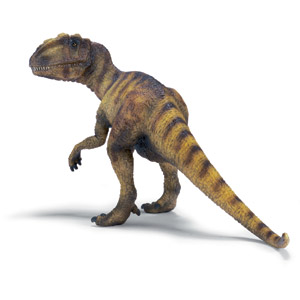Largest meat-eating Dinosaur Known to Date from Thailand
A group of palaeontologists working in the North-east of Thailand close to the village of Ban Saphan Hin in the Muang district have uncovered the fossilised bones of an Allosaurus – the largest carnivore found to date in the country.
Working in layers of sediment estimated to be 100 million years old (late Albian faunal stage), the scientists have uncovered the remains of several prehistoric animals, providing them with a unique insight into the ecosystem. As well as the partial remains of a member of the allosauroid family, iguanodontids and a duck-billed dinosaur (hadrosaur) have also been discovered. It is likely that these plant-eaters were the prey of the bigger allosaur. Without the complete skeleton it is difficult to estimate the size of this meat-eater but an examination of the teeth (some of which are more than 10 cm long) and other material indicates that this animal could have exceeded 10 metres in length.
Allosaurus Fossils
The allosaurs are a very widely distributed group of meat-eating dinosaurs, part of the order Theropoda. allosaur remains have been ascribed to Western USA, Africa and Portugal. There has even been evidence of allosaurs found in Australia.
Allosaurus was named and described by the American palaeontologist Othniel Charles Marsh in 1877. This is the same year that Stegosaurus was named and described. The terms Allosaurus and Stegosaurus have been used by palaeontologists for 130 years. An almost complete skeleton of Allosaurus (A. fragilis) was discovered in the United States in 1883. Many more articulated skeletons have been found and Allosaurus is one of the better known theropods. Allosaurus got its name “different lizard” as Marsh noted that the back bones (dorsal vertebrae) had cavities in their sides and this had not been seen in other dinosaur fossils at the time. These cavities (pleurocoels), probably contained air sacs and helped lighten the skeleton whilst retaining bone strength.
A Typical Allosaurus – Picture of Model Taken from the Schleich Series (Dinosaurs)
Picture credit: Everything Dinosaur
Models of Allosaurus and other meat-eating dinosaurs: Dinosaur and Prehistoric Animal Models.
Allosaurs were large predatory theropods with relatively deep skulls. Many had horns in front of the eyes or a row of bumps or hornlets along the tops of the nasal bones. The arms were much larger than in the later tyrannosaurs and they possessed three, sharply clawed fingers on each hand.
Late Jurassic Theropods
Scientists believe that the allosaurs had their hey day in the Late Jurassic but then went into decline during the Cretaceous (possibly due to competition from abelisaurids, spinosaurids and tyrannosaurs), but many genera seem to have survived in Gondwanaland and the southern continents.
A number of dinosaur fossils have so far been discovered, 1,000 fossils have been extracted and are awaiting further study. Thai scientists are being supported by palaeontologists from China as they bid to classify them all. The remains of a pterosaur (flying reptile) have also been recovered from the site.







Leave A Comment